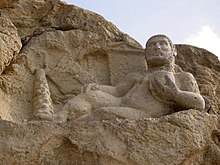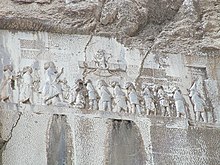Bisutun
Iran |

Bisotun (Behistan, Persian بیستون, Bīsotūn) is a village around 30 kilometers east of Kermanshah in western Iran . In the 2006 census, Bisotun had a population of around 2,000. A steep rocky ridge near this village (the so-called mountain of the gods of the same name ) and its surroundings is a historically significant place on the main connecting route between the Mediterranean and China.
The rock massif is home to several reliefs. The Achaemenid king Dareios I had the most important chiseled in. The pictorial representation, a good five meters wide and three meters high, shows Darius' victory over his main opponent Gaumata . With the scene, which is crowned by the winged sun disk of the god Ahura Mazda , Darius wants to legitimize his claim to the throne, which he himself in 19th century had to fight different battles. His proclamation in the inscription field below, the so-called Behistun inscription, comprises 1200 lines and is written in three languages in Old Persian, Elamite and New Babylonian. Therefore it was just as important for the deciphering of the cuneiform as the Rosetta Stone was for the Egyptian hieroglyphs.
About three meters above the path that leads up to the Darius relief, the Heracles relief from the time of the Seleucids was uncovered during road construction . It shows Herakles lying on a lion's skin with a beaker in his hand , almost fully sculpted . The inscription on his head dates the work to the year 148 BC.
Immediately behind it are the already heavily weathered Parthian reliefs . The left rock painting depicts four satraps who pay homage to King Mithridates II (124–87 BC). The right one commemorates the victory of the Parthian king Gotarzes II , who (shown on horseback) pierced his enemy (probably the opposing king Meherdates , 50 AD) with a spear. A 17th century inscription is carved over the reliefs.
Several caves in the rock massif show that the area was settled during the Middle Paleolithic .
literature
- Mahmoud Rashad: Iran (DuMont art travel guide), DuMont Buchverlag, Cologne 1998, ISBN 3-7701-3385-4 , pp. 190–192.
- Sylvia A. Matheson: Persia. An archaeological guide , Reclam-Verlag, Stuttgart 1980 (translation of the English edition from 1976), ISBN 3-15-010296-0 , pp. 146–153.
Web links
- Rock reliefs in Bisutun (English, with pictures)
- Entry on the UNESCO World Heritage Center website ( English and French ).
Coordinates: 34 ° 24 ' N , 47 ° 27' E



